The COVID-19 pandemic has two primary products: sickness and speculation. Experts struggle to predict the toll of the crisis, while respected models diverge widely. How many Americans will develop symptoms, fall seriously ill, or even die? Our best projections are hardly precise.
In the absence of scientific certainty, many of us consider grim probabilities. What are the odds that we’ll be infected or that the virus will claim vulnerable loved ones? Is a vaccine likely to arrive within a year?
In this project, we surveyed more than 1,000 Americans about their own coronavirus calculations, studying demographic differences in their views. We analyzed how age, education, and political affiliation might influence their fears (and hopes) about COVID-19. Which groups feel most likely to lose a loved one to the coronavirus – or even die themselves? Conversely, who believes that a vaccine is coming sooner than later?
For a strikingly personal view of the public’s pandemic predictions, explore our results below.
Personal Risk Probabilities
Older adults are at greater risk of serious illness and death due to COVID-19, particularly if they have underlying medical conditions. When we asked respondents to gauge their own likelihood of dying from the coronavirus, older Americans seemed deeply aware of their additional vulnerability.
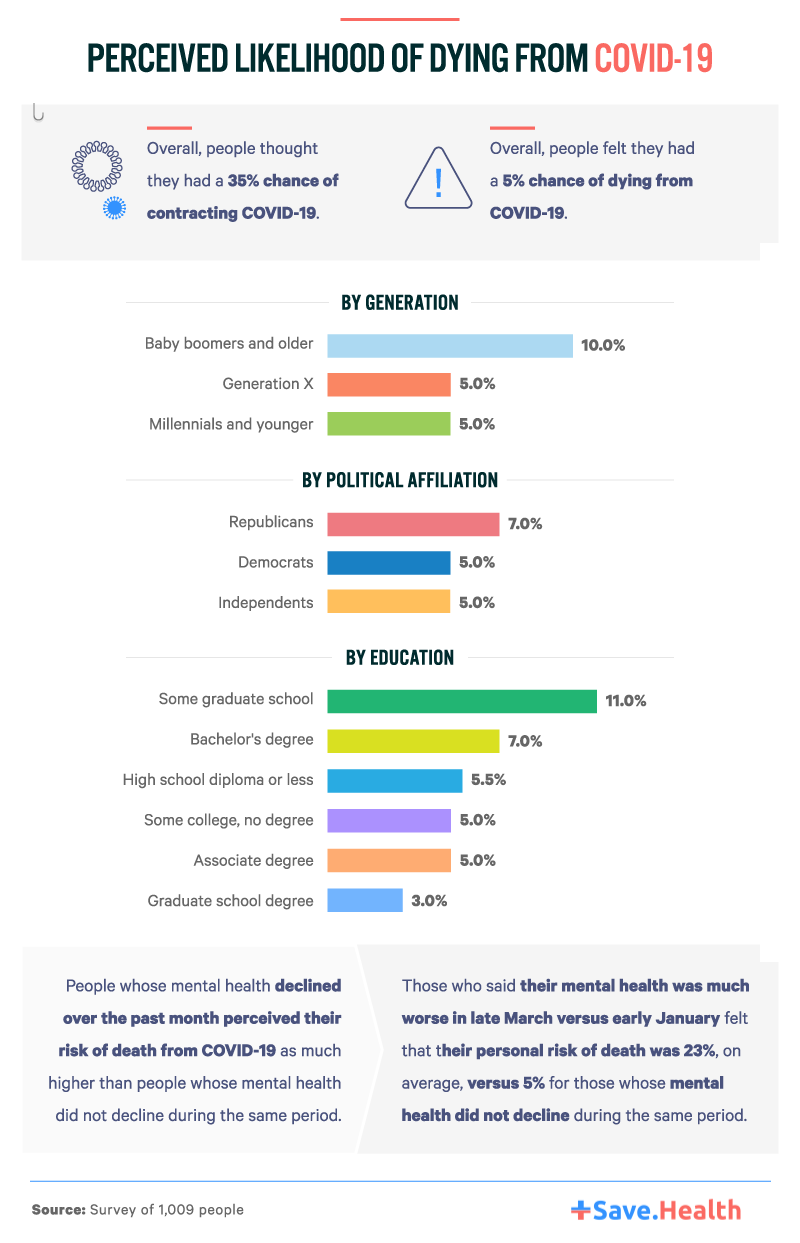
In contrast to reports of baby boomers downplaying their risk, older respondents viewed their odds of dying from COVID-19 as stunningly high, on average.
In fact, people across age groups tended to dramatically overestimate the fatality of the virus. Among our respondents, the median estimated chance of dying due to COVID-19 was 5%. Recent evidence suggests that fewer than 1% of people who are infected will die.
Interestingly, Republicans rated their chances of dying as higher than Democrats or Independents did, despite some polling indicating that concern is greatest among liberals.
Additionally, education did not seem to consistently prevent outsized coronavirus fears. While one might assume that individuals with advanced degrees would assess their risk analytically, the opposite actually proved true. Respondents with bachelor’s and some graduate level study estimated their odds of dying from coronavirus to be quite high, on avera far surpassing less-educated individuals.That said, for those with graduate degrees or above, we did see a lower overall estimation of risk.
Aside from demographic differences, mental health could also figure prominently in these dire predictions. Experts have warned of COVID-19’s potential psychological impacts, especially for those who may already be struggling. Indeed, respondents who reported that their mental health had worsened in recent months felt they were far more likely to die from the virus.
Fearing for Family
Beyond concerns about our own health, many respondents worried that COVID-19 may affect their family members. In fact, the typical respondent believed that there was a 15% chance that an immediate family member would die from the disease and a 20% chance of losing someone in their extended family.
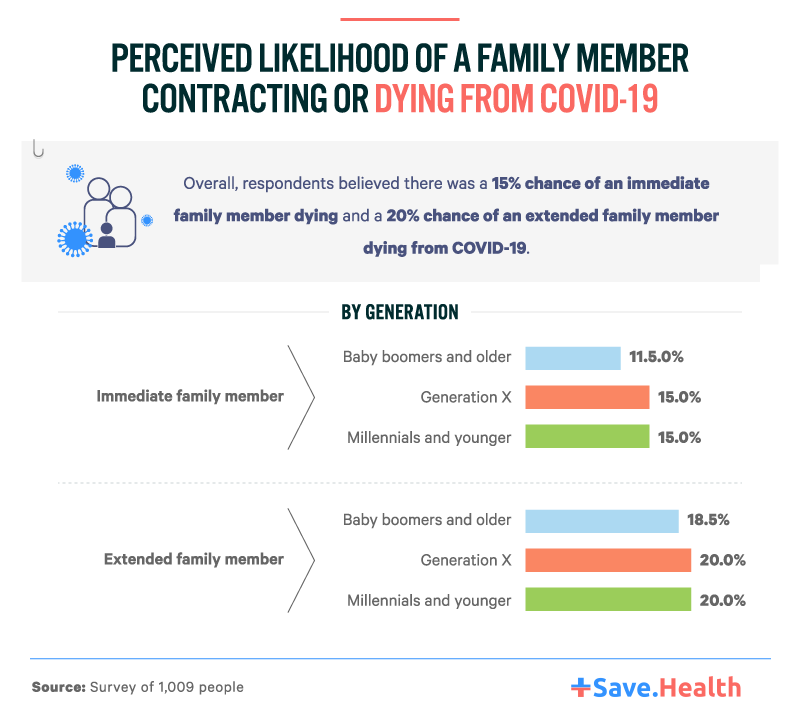
Indeed, concern about family members was significant in each age group: No generation felt sure their loved ones would be spared. This finding highlights an interesting intergenerational dynamic in our fears about COVID-19. Though young people have died in some rare cases, the vast majority experience manageable symptoms – or no symptoms at all. Accordingly, millennials are often more fixated on the safety of their parents or other older family members, urging their elders to take appropriate precautions.
Compared to other age groups, baby boomers tended to feel it was slightly less likely that immediate and extended family members might die from COVID-19. Somewhat oddly, this result could actually be a function of their own aging. Now that they’re among the oldest in their families, boomers’ living relatives may be fairly young and healthy.
Figuring Fatalities: From Friends to Public Figures
As the number of confirmed COVID-19 cases grows, many Americans will potentially learn of friends or acquaintances with the virus. Moreover, many celebrities have tested positive and shared their struggles with the public. Overall, our respondents tended to have grim views of the chances that someone in their social circle would succumb to the virus. Many felt there was also a strong chance a major celebrity would die from the disease.
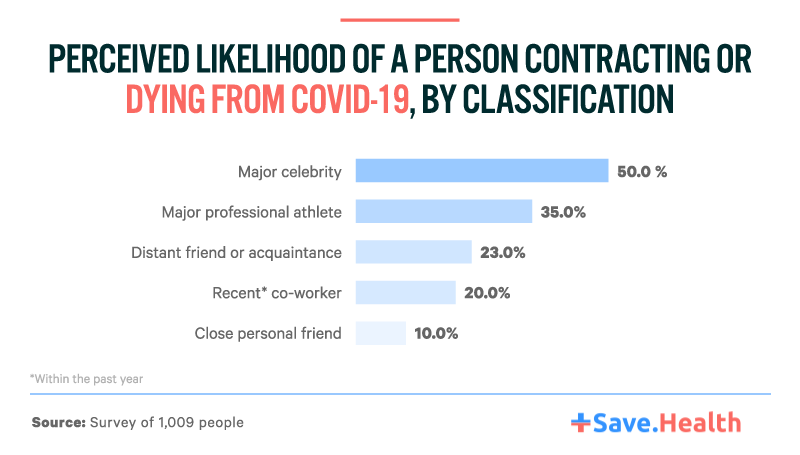
Respondents estimated that there was a 10% chance of a close personal friend dying from COVID-19. People were even more pessimistic when considering the odds that distant friends or co-workers could die from the virus. Loss on this scale is difficult to contemplate, particularly at a time when our normal grieving rituals are practically impossible. Experts have deemed coronavirus deaths “double traumas”: Mourners experience the sudden absence of someone they cared about and disconnection from people and traditions that might help them process this loss.
Estimating the odds that a major celebrity might die, our respondents’ median guess was 50%. Several public figures have already passed away from the coronavirus or related complications, so it’s not hard to imagine that a major star might succumb to COVID-19.
Similarly, the median estimate of the probability that a professional athlete might die was 35%. In some respects, these projections may seem overblown: Athletes tend to be young and fit and, thus, have great odds of recovering if infected. But the virus has heavily impacted many sports stars, particularly within the ranks of the NBA.
In Office, at Risk?
Despite widespread calls to put politics aside when confronting COVID-19, many Americans bring entrenched partisan perspectives to their views of the virus. Recent polling indicates that Democrats, Republicans, and Independents have differing views of the virus’s impacts and our government’s response. But could our politics also shape our sense of which politicians may be most vulnerable?
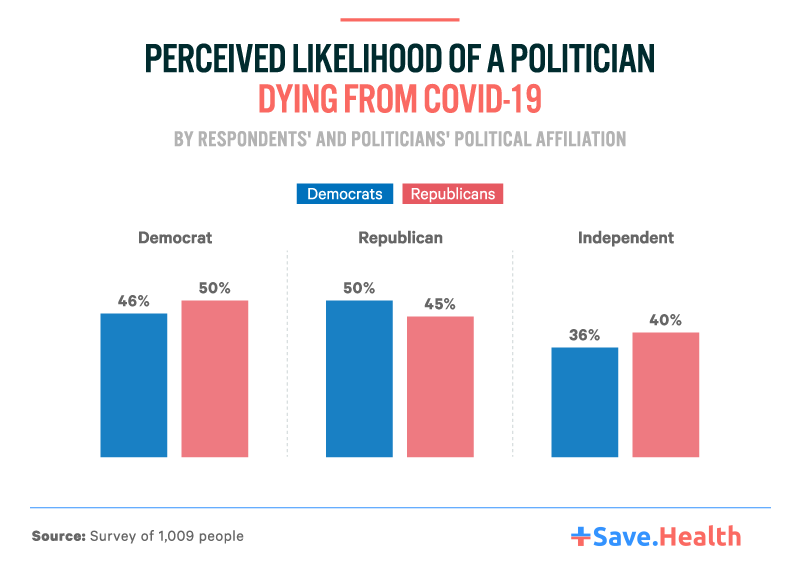
Our data indicate that party affiliation may influence our views of which elected officials may die due to COVID-19. Democrats, for example, tended to feel that Republican politicians were more likely to die than Democratic ones. Independents also viewed Republican politicians as more vulnerable.
These views could be informed by demographic considerations: Several high-profile Democrats in Congress are notably young and ostensibly less vulnerable. Additionally, the first major politician to test positive for the coronavirus was Rand Paul, a Republican from Kentucky.
On the other hand, Republicans tended to think that Democratic politicians were more likely to die. This view could also be supported with hard data: COVID-19 has thus far been concentrated in urban areas, which tend to be Democratic strongholds. Conservatives, meanwhile, tend to represent more rural areas.
Vaccination Anticipation
According to many public health officials, COVID-19 will continue to cause major challenges until a vaccine can be developed and distributed widely. But how long will it take for such a vaccine to arrive?
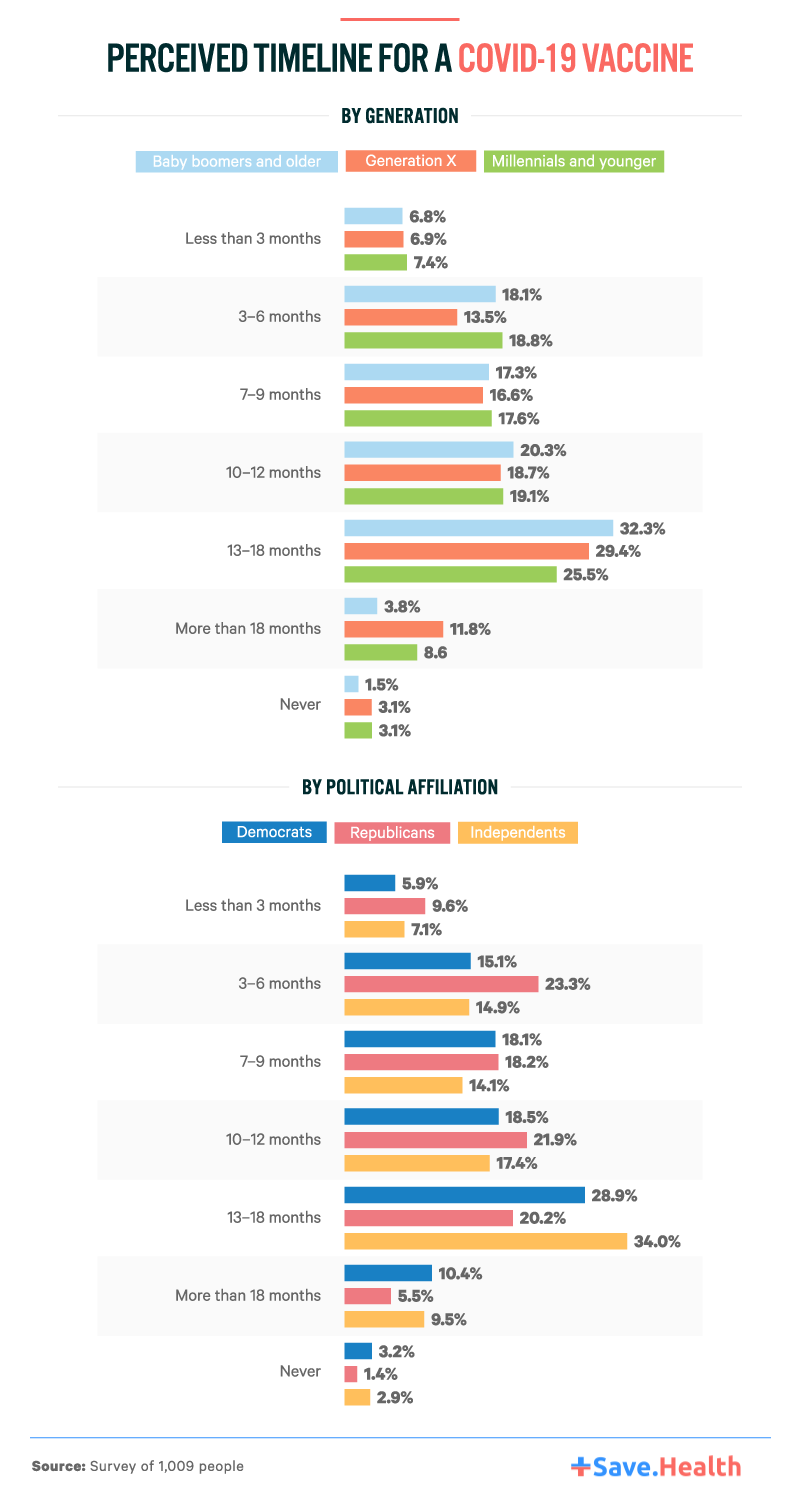
Relatively few people felt a vaccine would be available within just a few months, however much we’d all like it to be. Still, many individuals across the political spectrum did think that a vaccine would be available within the year. Even President Trump has voiced hopes that a vaccine may reach the public within the year – though White House officials have quickly corrected him. This may explain why Republican respondents tended to be more hopeful than Independents or Democrats about a vaccine arriving quickly.
Public health experts say that the more likely timeline is 12 to 18 months, due to the clinical trials necessary to demonstrate a vaccine’s safety. It seems this data point has been circulated successfully: This timeline was the most common estimate among our respondents overall. Thankfully, most people felt a vaccine would arrive at some point, with fewer than 10% of respondents believing a vaccine would never be created.
Acknowledging Uncertainty, Acting Constructively
Our results reveal surprising contrasts in COVID-19 concern, including several data points that seem disconnected from existing scientific evidence. Though the disease seems more devastating in men, for example, women were more likely to feel that the coronavirus could kill them.
More generally, every demographic group we studied significantly overestimated their own mortality risk. This held true across partisan divides, age groups, and educational levels: Individuals from all walks of life overestimated the coronavirus’s lethality.
Certainly, every life lost to this pandemic is one too many, and the specter of death is all too real. But outsized fears of dying may be painful and unproductive: Rather than worrying about an exaggerated sense of vulnerability, how might we better spend our energy? In a time when so little seems certain, this practical question may be most important.
As the pandemic continues to unfold, therefore, focus on known ways to reduce risk. Wash your hands frequently and thoroughly, practice social distancing, and disinfect surfaces where the virus might reside. While there’s much we can’t control in this unprecedented moment, these precautions can go a long way toward protecting yourself and the people you love.
Methodology and Limitations
We conducted a survey of 1,009 people and asked them questions related to their concerns around risk of contracting or dying as a result of Covid-19. The survey was conducted on March 30, 2020.
Forty-four percent of our respondents identified as female, 56% identified as male, and less than 1% identified as a gender not listed on our survey. Forty-four percent of respondents identified as Democrats, 29% identified as Republicans, 24% identified as Independents, and 3% identified as another party not listed on our survey. Respondents ranged in age from 19 to 76 with a mean of 38 and a standard deviation of 12.1.
Fair Use Statement
We encourage you to share this project in the spirit of solidarity: If you find yourself deeply worried about yourself and those you love, you’re certainly not alone. If you do decide to use any part of our work, we ask that you’ll include a link to this page so that others can explore our full project. Additionally, please use this content strictly for noncommercial purposes.


